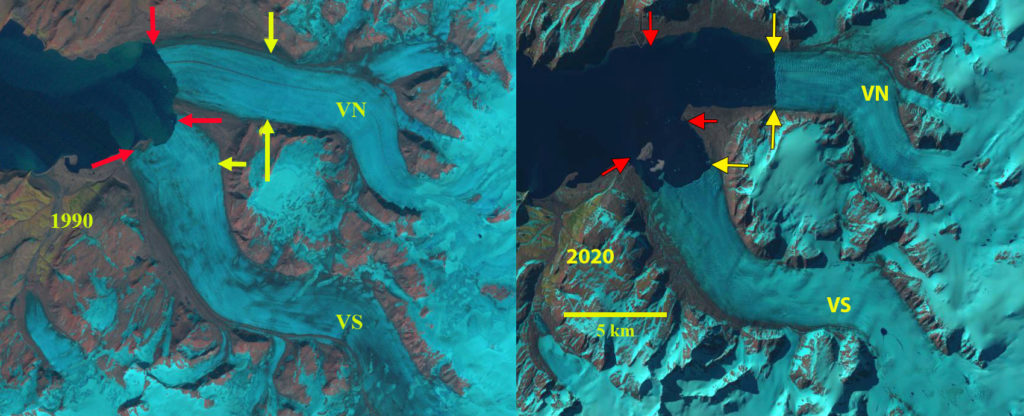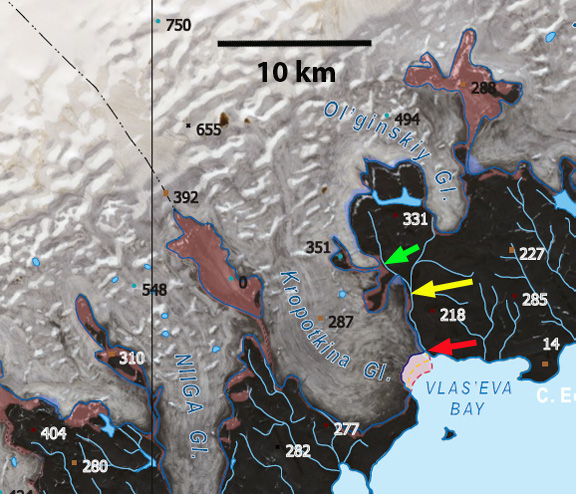Vilkitskogo Glacier North (VN) and South (VS) terminus in 1990 and 2020 Landsat images. Terminus in 1990 ends on an island forming. Red arrow is 1990 terminus, yellow arrow is the 2020 terminus. The 2020 image is from early June and shows low snowpack for so early in summer.
Vilkitskogo Glacier has two termini that had just separated in Vilkitsky Bay in 1990. The glacier flows from the Northern Novaya Zemlya Ice Cap to the west coast and the Barents Sea. The glacier has been retreating rapidly like all tidewater glaciers in northern Novaya Zemlya (LEGOS, 2006;)(Pelto, 2016), Carr et al (2014) identified an average retreat rate of 52 meters/year for tidewater glaciers on Novaya Zemlya from 1992 to 2010 and 5 meters/year for land terminating glaciers. For Vilkitskogo they indicate retreat into a widening fjord, and that the south arm has a potential bathymetric pinning point. The increased retreat rate has occured synchronously with sea ice cover depletion in the Barents Sea and sea surface temperature increases. Both factors would lead to increased calving due to more frontal ablation.
The north and south glaciers both terminated at the mouth of their respective fjords in 1990, with the southern arm ending on a small island/peninsula extension. In 1994 there is limited evident retreat. By 2001 embayments had developed particularly along the peninsula separating them and the south terminus still ended on a developing island. By 2015 Vilkitskogo North has retreated 5000 m along the northern side of the fjord and 4000 m along the south side since 1990. This fjord has no evident pinning points, and the rapid calving retreat should continue. Vilkitskogo South has retreated 1000 m on the west side and 1800 m on the east side. The retreat had exposed a new island in the center of the glacier. The glacier in 2015 terminates on another island. Retreat from this pinning point will allow more rapid retreat to ensue.
In 2020 the northern arm has retreated 5500 m since 1990 a rate of ~180 m/year. The southern arm has retreated from the island with an overall retreat of 2300 m, a rate of ~75 m/year.
The front of the terminus in each case remains heavily crevassed indicating high frontal velocity and ablation. This indicates the calving retreat will be ongoing. The retreat has the same unfolding story as Krivosheina, Nizkiy and Glasova Glacier and Krayniy Glacier.
Vilkitskogo Glacier terminus in 2020 Landsat image showing two new islands. Terminus in 1990 ends on an island forming. Red arrow is 1990 terminus, yellow arrow is the 2020 terminus.
Vilkitskogo Glacier terminus in 2001 and 2015 Landsat images. Terminus in 2001 ends on an island to be. Terminus in 2015 ends on a second island forming. Red arrow is 1990 terminus, yellow arrow is the 2015 terminus. Purple arrows show areas of expanding bedrock.





























